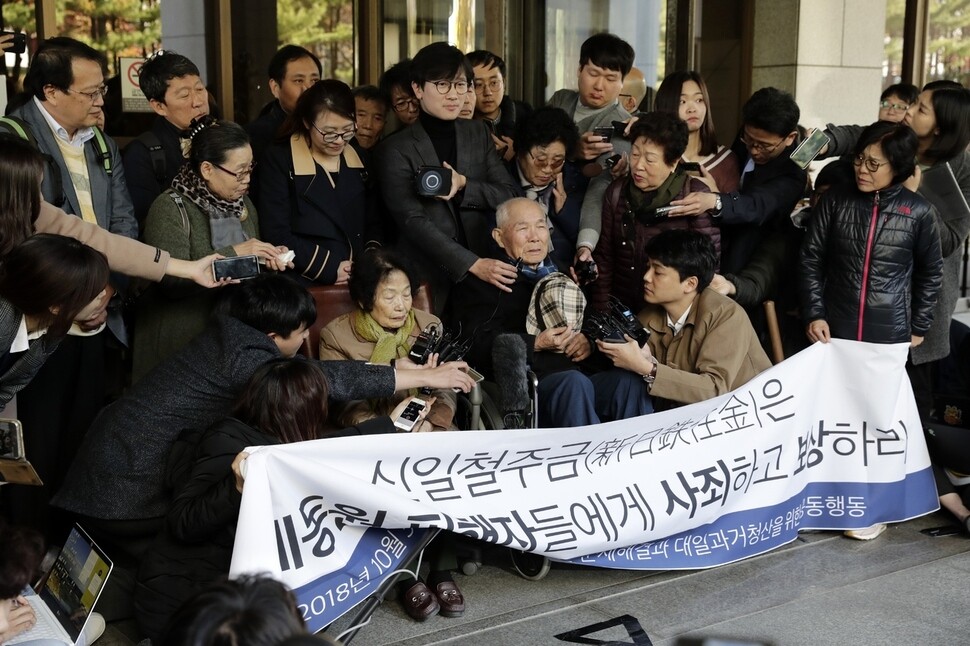hankyoreh
Links to other country sites 다른 나라 사이트 링크
Plaintiff in forced labor victim case passes away without seeing compensation

A victim of forced labor conscription recently passed away while involved in a lawsuit against Nippon Steel and Sumitomo Metal, a Japanese company implicated in past war crimes. Delays in rulings on forced labor cases by the South Korean Supreme Court under former Chief Justice Yang Sung-tae resulted in deferments in similar trials; now one more victim has died without seeing the trial’s outcome.
According to reports from the Center for Historical Truth and Justice (CHTJ) and legal experts, Nippon Steel conscription survivor Lee Sang-ju passed away from chronic illness on Feb. 15 while involved in a lawsuit against the company. He was 94 years old. Lee and six other conscription victims previously filed suit in March 2013 to demand damages from Nippon Steel. In the first trial, the court ruled for the plaintiffs in November 2015, ordering the company to pay 100 million won (US$89,069) to each of them. The company appealed, and an appellate trial was under way in Seoul High Court’s 13th civil affairs division at the time of Lee’s passing.
The reason the appellate trial has dragged on for over three years appears to lie with the Supreme Court, which waited until October 2018 to produce a final ruling in the first of the lawsuits claiming damages, filed by 95-year-old Lee Choon-sik and two other conscription survivors. Lee’s case was not heard by the Supreme Court for over five years following a July 2013 reversal and remand ruling. It was this case where former Chief Justice Yang Sung-tae deliberately delayed the second appellate trial to satisfy the Blue House and Ministry of Foreign Affairs under the Park Geun-hye administration. Only in October of last year did the Supreme Court finally uphold the original ruling ordering the company to pay 100 million won to Lee Choon-sik and the two other plaintiffs.
As a 17-year-old, Lee Sang-ju was taken to work at the Kamaishi steelworks in Japan’s Iwate Prefecture in Oct. 1942. He was compelled to go when a township employee informed him that his older brother would be seized and sent in his place if he did not. Lee continued working there until May 1943, carting raw ore and coal to a furnace to produce metal. His only meals were rice, fermented soybean soup, and radish slices, he recalled.
“Lee Sang-ju was anxiously awaiting the result of his trial, traveling up to Seoul from Boryeong in South Chungcheong Province to participate in every press conference and rally,” said CHTJ senior research fellow Kim Jin-young on Feb. 19.
“Due to the Supreme Court’s failure to make an initial ruling, these trials have dragged on, and several victims have passed away since last year without ever seeing the outcome of their trial,” Kim said.
Only one surviving plaintiff remaining
With Lee Sang-ju’s passing, Lee Choon-sik – who already received a Supreme Court ruling in his family – is now the only surviving conscription victim involved in legal action against Nippon Steel. In Nov. 2018, an appellate court ruled in favor of three family members of late conscription victim Kim Gong-su in another case filed in May 2015 to demand damages from Nippon Steel. That case is currently pending in the Supreme Court.
To date, Nippon Steel has followed the Japanese government’s position opposing payment of compensation, stating that it will “respond appropriately in accordance with the government’s response situation.” Conscription survivors and their legal representatives have paid a series of protest visits to Nippon Steel headquarters in Tokyo to demand payment of compensation. Meanwhile, the Pohang branch of Daegu District Court moved on Jan. 8 to approve an application by Lee Choon-sik and others to seize Nippon Steel assets in South Korea.
By Choi Woo-ri, staff reporter
Please direct comments or questions to [english@hani.co.kr]

Editorial・opinion
![[Column] Park Geun-hye déjà vu in Yoon Suk-yeol [Column] Park Geun-hye déjà vu in Yoon Suk-yeol](https://flexible.img.hani.co.kr/flexible/normal/500/300/imgdb/original/2024/0424/651713945113788.jpg) [Column] Park Geun-hye déjà vu in Yoon Suk-yeol
[Column] Park Geun-hye déjà vu in Yoon Suk-yeol![[Editorial] New weight of N. Korea’s nuclear threats makes dialogue all the more urgent [Editorial] New weight of N. Korea’s nuclear threats makes dialogue all the more urgent](https://flexible.img.hani.co.kr/flexible/normal/500/300/imgdb/original/2024/0424/7317139454662664.jpg) [Editorial] New weight of N. Korea’s nuclear threats makes dialogue all the more urgent
[Editorial] New weight of N. Korea’s nuclear threats makes dialogue all the more urgent- [Guest essay] The real reason Korea’s new right wants to dub Rhee a founding father
- [Column] ‘Choson’: Is it time we start referring to N. Korea in its own terms?
- [Editorial] Japan’s rewriting of history with Korea has gone too far
- [Column] The president’s questionable capacity for dialogue
- [Column] Are chaebol firms just pizza pies for families to divvy up as they please?
- [Column] Has Korea, too, crossed the Rubicon on China?
- [Correspondent’s column] In Japan’s alliance with US, echoes of its past alliances with UK
- [Editorial] Does Yoon think the Korean public is wrong?
Most viewed articles
- 1[Column] Park Geun-hye déjà vu in Yoon Suk-yeol
- 2Will NewJeans end up collateral damage in internal feud at K-pop juggernaut Hybe?
- 3Thursday to mark start of resignations by senior doctors amid standoff with government
- 4Why Korea shouldn’t welcome Japan’s newly beefed up defense cooperation with US
- 5‘We must say no’: Seoul defense chief on Korean, USFK involvement in hypothetical Taiwan crisis
- 6[Guest essay] The real reason Korea’s new right wants to dub Rhee a founding father
- 7N. Korean hackers breached 10 defense contractors in South for months, police say
- 8[Column] ‘Choson’: Is it time we start referring to N. Korea in its own terms?
- 9[Editorial] New weight of N. Korea’s nuclear threats makes dialogue all the more urgent
- 10Kim Jong-un expressed ‘satisfaction’ with nuclear counterstrike drill directed at South